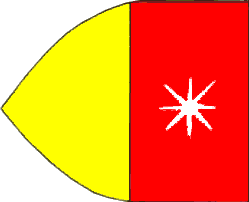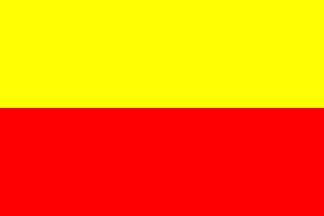
image by António Martins-Tuválkin, 17 November 2007

Last modified: 2009-08-15 by dov gutterman
Keywords: slavonia |
Links: FOTW homepage |
search |
disclaimer and copyright |
write us |
mirrors
See also:
Quoted from <www.hr/hrvatska/HRgradovi/Slavonija/Slavonija.html>:
"Slavonia and Baranya occupies the eastern part of the
Croatia, being covered by the territories of five counties. The Slavonski Brod and Sava Basin County, the Osijek and Baranya County, the Pozega and Slavonia County, the Vukovar and Srijem County and the Virovitica and Drava Basin County. "
I.e. Slavonia is region of Croatia between rivers Sava and Drava
(and Baranya is on "other" side of Drava).
Historically, Croatia was known as kingdom of Croatia and
Slavonia within the Hungarian kingdom and Dalmatia within
Austrian part of Habsburg empire.
However, the Coat of Arms shown there is wrong. The three martens
Coat of Arms is shown on some old maps, including one map made in
17th century which was rather popularized here due to a high
quality reprint made some 15 years ago (I happened to have a copy
of it above my desk). I'm almost sure that the image on the site
is scanned from that reprint. The Coat of Arms that should have
been used is the Slavonian Coat of Arms representing a marten
running on red (or earlier also green) field between two wavy
lines of white all on blue background and with a mullet Or in
chief. Something like the sinistermost Coat of Arms in the crest
over the Coat of Arms on Croatian flag.
Željko Heimer and Dov Gutterman , 4 March
2000

image by António Martins-Tuválkin, 17 November 2007
The 33rd flag mentioned and illustrated in the Book of All
Kingdoms [e9s50], late 14th cent.,
is attributed to "Esclavonia", a Spanish archaism for
Slavonia. This as depicted in the 2005 spanish illustrated
transcription [e9s05], a
vertically divided flag, red at the hoist with a small white
8-pointed star on the middle and yellow in the fly side; the flag
shown in the ogival default shape of this source.
The anonymous author of [e9s50]
describes the flag thusly: «E el rey d’esta Esclavonia á
por seńales un pendón amarillo a meitades, en la meitad bermeja
que está cerca la vara está una estrella blanca, e la otra
meitad del cabo es amarilla atal.» (And the king of this
Slavonia has for sign a yellow pendon in halves, on the red half
which is near to the rod is a white star and the other half at
the end is yellow like this.)
António Martins-Tuválkin, 17 November 2007
"Esclavonia" stands indeed for Slavonia - although
this name today refers to that part of Croatia between rivers of
Drava and Sava in the east of the country, in medieval period, it
was the name used for entire Croatia excluding present day
Dalmatia, but including parts of modern north-eastern Bosnia more
or less. The device show is the "banner of arms" of the
family of Frangopan (Frankopani, Frangipani), princes who ruled
large pats of (modern) north-western Croatia, with
the seat on the island of Krk. Numerous present day coats of arms
(and flags) of cities and communities in croatia refer in this or
that manner to the historical importnat family and their
red-yellow Coat of Arms with a star.
This Coat of Arms is reflected in many modern designs. The one
that comes to mind is for example Josipdol
(Karlovac County, Croatia), although this may not be the best
example. It may well be that the red-yellow flag of the Karlovac county is also reflecting this old
Coat of Arms of Frankopan princes. Frankopan family used an other
Coat of Arms as well showing two lions rampant breaking bread,
reflected in a number of other modern Coat of Arms (and flags) as
well.
Željko Heimer, 19 November 2007

image by Tomislav Todorovic, 6 January 2009
Here is a flag from Slavonia, Croatia, which was published in
the flag chart by Pieter Schenk (1711):
The flag chart created by Dutch cartographer Pieter Schenk in
1711, which was published in the atlas by Guillaume Delisle of
France in 1730 (reissued in 1739 as the "Nouvel atlas"
by Covens & Mortier of Amsterdam), contains a yellow-red
horizontal bicolour with the title "Slavonien", which
is grouped with the flags from the Ottoman Empire [1]. Schenk's
source for this flag is not known to me, so I can only guess
about its origins: its design resembles that of the flag of
Slavonia from the "Book of All Kingdoms", so it is
possible that the 1711 flag was somehow derived from that source,
most probably indirectly. Another mystery is how this flag was
placed among those from the Ottoman Empire, knowing that Slavonia
was liberated from the Ottoman rule by 1699. A possibility, which
is yet to be verified, is that the flag was actually meant to
represent parts of the Balkans inhabited by the Slavic peoples,
which were still under the Ottoman rule in 18th century.
This would get along with the "Book of All Kingdoms" as
the possible source, because the country of Slavonia described
there seems not to include only present-day Slavonia and
neighbouring parts of Croatia, but also Serbia, Bulgaria and even
Albania ("kingdom of Durres") [2]:
"Con esta Narent confina una cibdat que dizen Dulcerno e con
los montes de Acerua, una tierra muy viciosa e abondada. Con este
reinado de Acervia confina el reino de Burgaria e el reino de
Daraze, que son en la provincia de Esclavonia." [3]
These strange geographic ideas might be somehow derived from
Hungarian kings' medieval claims to Serbia and Bulgaria, combined
with the rule of Angevin kings of Naples over Durres -
"Kingdom of Albania" - and their claims to the
Hungarian crown, which were temporarily accomplished in 1385-86
under Charles III of Naples (II of Hungary), all of these having
been mixed up during the writing of the original book and/or some
of its later copies.
Schenk's chart also contains a flag attributed to Greece, which
was also under the Ottoman rule at that time [1]. This would also
speak in favour of the idea about the flag of
"Slavonia" as the flag attributed to all the Balkan
Slavs. Still, considering that the present-day Slavonia was under
the Ottoman rule almost until the time of creation of this flag
chart, the described flag might be freely attributed to it as
well.
Sources:
[1] Allen, Phillip: The Atlas of Atlases London: Bounty Books,
2005 (C) 1992 Marshall Editions ISBN 0-7537-1311-X ISBN-13
978-0-7537-1311-2
[2] Solovjev, Aleksandar: Zemlje Juz<nih Slovena i njihovi
grbovi u s<panskom putopisu XIV veka. Istorija srpskog grba i
drugi heraldic<ki radovi Pravni fakultet Univerziteta u
Beogradu: Dosije; Belgrade, 2000 ISBN 86-80763-90-X
[3] Libro del Conoscimiento. Viajes medievales, vol. I Madrid:
Fundacio'n Jose' Antonio de Castro, 2005 ISBN 84-96452-11-5
(complete edition) ISBN 84-96452-12-3 (vol. I)
It was not possible to determine the aspect ratio absolutely
precisely, because the flag was depicted as if flying in the wind
(typical for the flag charts until the end of 19th century), but
2:3 is a very close approximation, if not the very precise value.
Tomislav Todorovic, 6 January 2009I am inclined to
believe that this flag is nothing but a product of fancy of the
cartographer, or whatever source he was using. It may be that it
is a descendant of those earlier portolanos showing the yellow
and red (with a yellow star) flag for the various Croatian parts,
being derived from the old Coat of Arms of Frangepans.
Željko Heimer, 12 January 2009